
Andrey Krylov
Lomonosov Moscow State University, Russia
- Title of the talk:
How to choose adaptively parameters of image denoising methods?
- Abstract:
In this report we present a multiscale method for automatic choice of the parameters for wide class of image ridge and edge preserving denoising algorithms. The approach will be illustrated with the following denoising methods: BM3D, Non-Local Means (NLM), Local Jets Based Non-Local Means (LJNLM-LR), Bilateral, Anisotropic diffusion, Total Variation, Total Generalized Variation and Wavelet-based. All of them depend on their filtering strength parameters.
In the ideal case, optimal parameters are chosen basing on optimization of some metric (for example, PSNR) between filtered image and the source image without noise (or,reference image). Nevertheless in practice we need to use methods that work without reference image (no-reference methods). Methods to estimate image denoising quality compute a no-reference image quality assessment value. These methods usually calculate image local spatial statistics,or statistics in the frequency domain. However, these methods do not take into account the condition of image structure preserving. To control these structures by ridge based approach we calculate image denoising quality using difference between noisy and filtered images (so called method noise). Presence of regular structures in the ridge areas of the method noise image shows ridge smoothing or suppression by the testing denoising algorithm.
Appearance of regular components on method noise is controlled using mutual information. Hessian matrix eigenvalues analysis is used for estimation of sizes and directions of image characteristic details. Images with added controlled Gaussian noise from general image databases were used for testing. It was found that the proposed no-reference metric outperforms existing no-reference metrics in selecting optimal denoising parameter.
The report will also include a short discussion on the current importance of the above “classical” denoising methods and their cooperation with the CNN-based denoising methods.
- Short biography:
Andrey Krylov received the M.S., Ph.D., and Dr.Sc. degrees from the Faculty of Computational Mathematics & Cybernetics, Lomonosov Moscow State University (CMC MSU) in 1978, 1982 (supervisor – academician Andrey Tikhonov), and 2009, respectively. He was a member of scientific staff (1981-1988), senior researcher (1988-1998), head scientist (1988-2003), associated professor (2003-2009) CMC MSU and he is currently professor, head of the Laboratory of Mathematical Methods of Image Processing (http://imaging.cs.msu.ru). During his career he worked in applied mathematics in areas of nuclear physics, physical chemistry of liquid systems, multimedia and biomedical imaging. In 1989 he received the Leninsky Komsomol Scientific Prize - the highest prize for scholars in the USSR. He has authored or coauthored over 150 published papers. He served as a reviewer for several international journals and conferences; he was in the board of international and national conferences. For a long period of time he is one of the organizers of the GraphiCon conference - the main international computer graphics, computer vision and image processing conference in Russia.